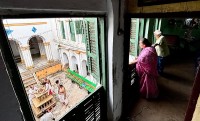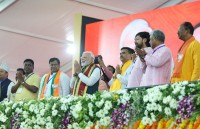image
Budget Session 2017: Economic Survey 2016-17 presented by FM Arun Jaitley
New Delhi, Jan 31 (IBNS): The Indian economy has sustained a macro-economic environment of relatively lower inflation, fiscal discipline and moderate current account deficit coupled with broadly stable rupee-dollar exchange rate despite continuing global sluggishness, said Union Minister Arun Jaitley in the Parliament on Tuesday.
He presented the Economic Survey 2016-17 in the Parliament on Tuesday, the first day of the Budget Session 2017.
Excerpts from the Survey:
As per the advance estimates released by the Central Statistics Office, the growth rate of GDP at constant market prices for the year 2016-17 is placed at 7.1 per cent, as against 7.6 per cent in 2015-16.This estimate is based mainly on information for the first seven to eight months of the financial year. Government final consumption expenditure is the major driver of GDP growth in the current year.
Fixed investment (gross fixed capital formation) to GDP ratio (at current prices) is estimated to be 26.6 per cent in 2016-17, vis-à-vis 29.3 per cent in 2015-16.
For 2017-18, it is expected that the growth would return to normal as the new currency notes in required quantities come back into circulation and as follow-up actions to demonetisation are taken. On balance, there is a likelihood that Indian economy may recover back to 6 ¾ per cent to 7 ½ per cent in 2017-18.
Fiscal
Indirect taxes grew by 26.9 per cent during April-November 2016.
The strong growth in revenue expenditure during April-November 2016 was boosted mainly by a 23.2 per cent increase in salaries due to the implementation of the Seventh Pay Commission and a 39.5 per cent increase in the grants for creation of capital assets.
Prices
The headline inflation as measured by Consumer Price Index (CPI) remained under control for the third successive financial year. The average CPI inflation declined to 4.9 per cent in 2015-16 from 5.9 per cent in 2014-15 and stood at 4.8 per cent during April-December 2015.
Inflation based on Wholesale Price Index (WPI) declined to (-) 2.5 per cent in 2015-16 from 2.0 per cent in 2014-15 and averaged 2.9 per cent during April-December 2016.
Inflation is repeatedly being driven by narrow group of food items, of these pulses continued to be the major contributor of food inflation.
The CPI based core inflation has remained sticky in the current fiscal year averaging around 5 per cent.
Trade
The trend of negative export growth was reversed somewhat during 2016-17 (April-December), with exports growing at 0.7 per cent to US$ 198.8 billion. During 2016-17 (April-December) imports declined by 7.4 per cent to US$ 275.4 billion.
Trade deficit declined to US$ 76.5 billion in 2016-17 (April-December) as compared to US$ 100.1 billion in the corresponding period of the previous year.
The current account deficit (CAD) narrowed in the first half (H1) of 2016-17 to 0.3 per cent of GDP from 1.5 per cent in H1 of 2015-16 and 1.1 per cent in 2015-16 full year.
Robust inflows of foreign direct investment and net positive inflow of foreign portfolio investment were sufficient to finance CAD leading to an accretion in foreign exchange reserves in H1 of 2016-17.
In H1 of 2016-17, India’s foreign exchange reserves increased by US$ 15.5 billion on BoP basis.
During 2016-17 so far, the rupee has performed better than most of the other emerging market economies.
External Debt
At end-September 2016, India’s external debt stock stood at US$ 484.3 billion, recording a decline of US$ 0.8 billion over the level at end-March 2016.
Most of the key external debt indicators showed an improvement in September 2016 vis-à-vis March 2016. The share of short-term debt in total external debt declined to 16.8 per cent at end-September 2016 and foreign exchange reserves provided a cover of 76.8 per cent to the total external debt stock.
India’s key debt indicators compare well with other indebted developing countries and India continues to be among the less vulnerable countries.
Agriculture
Agriculture sector is estimated to grow at 4.1 per cent in 2016-17 as opposed to 1.2 per cent in 2015-16; the higher growth in agriculture sector is not surprising as the monsoon rains were much better in the current year than the previous two years.
The total area coverage under Rabi crops as on 13.01.2017 for 2016-17 is 616.2 lakh hectares which is 5.9 per cent higher than that in the corresponding week of last year.
The area coverage under wheat as on 13.01.2017 for 2016-17 is 7.1 percent higher than that in the corresponding week of last year. The area coverage under gram as on 13.01.2017 for 2016-17 is 10.6 percent higher than that in the corresponding week of last year.
Industry
Growth rate of the industrial sector is estimated to moderate to 5.2 per cent in 2016-17 from 7.4 per cent in 2015-16.During April-November 2016-17, a modest growth of 0.4 per cent has been observed in the Index of Industrial Production (IIP).
The eight core infrastructure supportive industries, viz. coal, crude oil, natural gas, refinery products, fertilizers, steel, cement and electricity registered a cumulative growth of 4.9 per cent during April-November 2016-17 as compared to 2.5 per cent during April-November 2015-16.
The production of refinery products, fertilizers, steel, electricity and cement increased substantially, while the production of crude oil, natural gas fell during April-November 2016-17. Coal production attained lower growth during the same period.
The performance of corporate sector (Reserve Bank of India, January 2017) highlighted that the growth of sales grew by 1.9 per cent in Q2 of 2016-17 as compared to near stagnant growth of 0.1 per cent in Q1 of 2016-17. Growth in net profit registered a remarkable growth of 16.0 per cent in Q2 of 2016-17 as compared to 11.2 per cent in Q1 of 2016-17.
Services
Service sector is estimated to grow at 8.9 per cent in 2016-17, almost the same as in 2015-16. It is the significant pick-up in public administration, defence and other services, boosted by the payouts of the Seventh Pay Commission that is estimated to push up the growth in services.
Social Infrastructure, Employment and Human Development
The Parliament has passed the “Rights of Persons with Disabilities Act, 2016”. The Act aims at securing and enhancing the rights and entitlements of Persons with Disabilities. The Act has proposed to increase the reservation in vacancies in government establishments from 3 per cent to 4 per cent for those persons with benchmark disability and high support needs.
Top Headlines
-
News
Benjamin Netanyahu delays India visit again, cites security after Delhi bomb blast
November 25, 2025
-
News
PM Modi raises saffron flag over Ram Mandir! 500-year dream finally fulfilled in historic ceremony at Ayodhya
November 25, 2025
-
News
Justice Surya Kant swears in as 53rd Chief Justice of India
November 24, 2025
-
News
India-Pakistan borders may change: Defence Minister Rajnath Singh says 'Sindh may return to India'
November 23, 2025
-
News
Technology must stay human-centric, says PM Modi during G20 session on AI
November 23, 2025
-
News
TMCs Humayun Kabir sparks controversy with call to lay Babri Masjid foundation in Murshidabad
November 23, 2025
-
News
Punjab leaders push back against Centres plan to bring Chandigarh under Presidents rule
November 23, 2025
-
News
Pakistan on full alert as defence minister says all-out war with India cannot be ruled out
November 20, 2025
-
News
Historic moment! Nitish Kumar takes oath as Bihar CM for record 10th time PM Modi and Amit Shah witness ceremony
November 20, 2025
-
News
Delhi blast fallout: Al-Falah University founders Mhow house declared 'illegal' demolition looms
November 20, 2025





